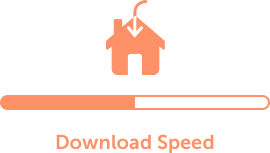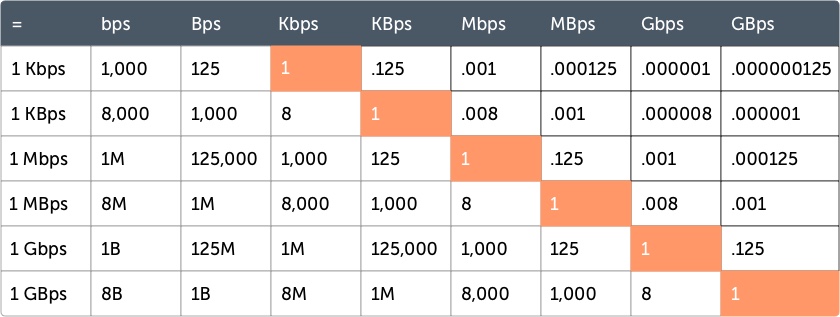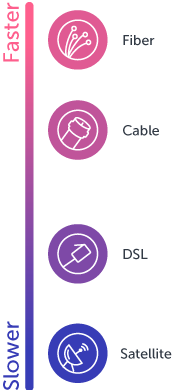Your internet speed is the volume of data packets transferred through a connection in a given amount of time.
Ok, let’s break that information down a little bit. Devices connected to the internet transfer information to each other in electronic packets. A packet is simply a unit of data. Everything you do online relies on the transfer of these packets from the internet to your device and vice versa.
Having a fast internet speed is important because the internet uses a lot of data. Zoom calls, streaming videos, online gaming, and scrolling through social media all require several packets per second to operate smoothly. You could technically stream a movie by watching one or two frames at a time, waiting for it to buffer, and then watching another two frames, but nobody wants to do that.
And as the world moves into more virtual spaces for education, health care, work, and entertainment, having a fast internet connection is more of a necessity than a luxury.
Testing your speed
Knowing your internet speed and how it compares to recommendations from services like Netflix and Hulu can help you get the most out of your connection. You should also test your speed regularly to make sure you’re getting the speeds you pay for.

Knowing your internet speed will also help you find the best deal on internet service because when an internet service provider (ISP) advertises a promotional special, you’ll have a reference point to know if the speed it’s offering is actually faster than what you already have.
Upload speed vs. download speed
After you finish the speed test, you’ll see two numbers in the results: one is your upload speed and the other is your download speed.

Download speed is the speed at which information travels from the internet to your internet-connected device. For example, if you open the Facebook app on your phone, your download speed would determine how long it takes to load your feed.

Upload speed is the opposite. It is the speed at which information travels from your internet-connected device to the internet. So if you post to your Facebook timeline, your upload speed would determine how long it takes your post to get to the Facebook server for all your friends to see.
Upload speed, download speed, and your internet activities
With most internet plans, download speeds are much faster than upload speeds. This makes sense because consumers generally download much more information than they upload. Many online activities don’t really need upload bandwidth once they’re initiated:
- Streaming music or videos
- Reading an article or blog post
- Scrolling through your social media feed
- Downloading files
Upload speeds become much more important for interactive applications. Things like video conferencing, online gaming, and sharing large files require more upload bandwidth. Slow upload speed can cause choppy video calls and long waits to upload files.


Of bits and bytes
Internet speed is a measure of the rate at which information is transferred from one place on the internet to another. That measurement can be expressed in several ways, but the first step to understanding it is to understand the units of electronic information.
Electronic information is any piece of information stored or used by a computer or internet device. It tells computers what to do, what to display, and how to interact with each other. The most basic unit of electronic information is called a bit. A bit is expressed as either a one or a zero as part of the binary code that makes computers work.
In most binary code, eight bits are combined in a series, each with a value of one or zero. The combined series of bits is one byte of information.

The variation in the values of the bits in a byte determines what information that byte represents. This means one byte could represent any of 256 possible pieces of information. Those bytes can then work together to create even more variety. Nearly all electronic information—from the display on a basic calculator to the stream of an HD blockbuster—is made up of these bits and bytes.
Bits per second
When computers send information over the internet, that information is in bits or bytes. The bits or bytes take time to reach their destination. That time is measured in seconds. So internet speeds are measured by identifying how many bits or bytes are transferred in one second, hence bits per second, or bytes per second.
Because the bits and bytes are so small, the number transferred in a single second is almost always well over 1,000. The common practice is to express those large numbers using the metric-based prefixes:
- kilo for 1,000
- mega for 1 million
- giga for 1 billion
Putting this all together, internet speeds can be measured in several different ways as well.
- kilobits per second (Kbps)
- kilobytes per second (KBps)
- megabits per second (Mbps)
- megabytes per second (MBps)
- gigabits per second (Gbps)
- gigabytes per second (GBps)
While any of these expressions of speed could be technically correct, internet service providers usually advertise the capacities of their services using the bits measurements of Kbps, Mbps, or Gbps, over the bytes measurements, presumably because the numbers look eight times bigger.
Internet speed conversion chart

Most internet speeds are expressed in Mbps. Upload speeds and very slow download speeds are sometimes measured in Kbps. However, over the past decade, top-end internet speeds have increased, and the fastest internet speeds are now often measured in Gbps.
Bandwidth
While “bandwidth” and “internet speed” are often used interchangeably, they actually refer to two different aspects of internet service. Internet speed is the measure of how fast information is transferred, while bandwidth refers to the capacity of an individual internet connection. So if your internet connection has a bandwidth of 5 Mbps, your speed would only be that fast if it’s operating at full capacity.
Several factors can slow your internet speed from reaching its full bandwidth, but a connection’s bandwidth will always cap how fast it can transmit information over the internet. This is why ISPs list their internet services with speeds “up to” a given speed. They aren’t really advertising the speeds of their services; they’re advertising the bandwidth of their connections by informing you of the highest speed those connections are capable of transmitting.
Broadband
The term “broadband” has largely been replaced by “high-speed internet,” but this carries the same false-equivalency as referring to “bandwidth” as “internet speed.”
As internet connection technology improved, particularly in the 1990s, it allowed the transmission of information over a much larger variety of frequencies. Thus the term “broadband” was used to describe this wide (broad) range of frequencies (bands).
In the current vernacular, broadband essentially refers to any type of internet connection except dial-up, but according to the FCC, an internet service must deliver at least 25 Mbps download speed and at least 3 Mbps upload speed to qualify as broadband.
So what are the different types of internet?
Types of internet and how they affect your speed
Internet connections come in five basic types: dial-up, DSL, cable, fiber, and satellite.

Fiber internet is the fastest widely available internet technology. It uses fiber-optic cables, which are capable of transmitting large amounts of information quickly. While fiber is fast, it isn’t available in as many areas as other types of internet. Much of the limitation in its availability stems from the high cost of creating its network infrastructure.
Cable internet uses the same types of cables that transmit cable TV services. It has broadband capability and thus can reach high speeds. It is usually available through current or former cable TV providers in their respective areas. Cable internet speeds are usually similar to DSL speeds, but can be even faster in some areas.
DSL, short for Digital Subscriber Line, uses a connection that looks similar to a phone line, but the wiring inside is different and allows for broadband transmission. This makes DSL much faster than dial-up. Current or former telephone companies that also provide internet service often use this technology, and it is usually available throughout their service areas.
Satellite internet is delivered wireless to the receiver, but it still requires wires to transport the signal from the receiver to different locations throughout the building. Because it’s wireless, it’s available almost anywhere in the United States. Satellite internet has bandwidth comparable to DSL and cable but can often feel slower due to latency.
Dial-up is the slowest connection technology because it can’t support broadband and thus has limited bandwidth. (See the previous section for more information about this.) Because of its technological limitations, it is almost obsolete.
Latency
Latency is the time required for a signal to travel from one computer to another computer on the network and back. In terms of internet service, latency usually means the time required for a signal to travel to the ISP’s server and back.
Latency is often referred to using different terms, including ping, ping rate, and lag. People use these interchangeably, but they actually mean different things:
- Latency is the time it takes for a signal to make a round-trip journey from your computer to the ISP and back.
- Ping rate is the measure of latency, usually in milliseconds.
- A ping is the signal sent to test latency.
- Lag is a result of latency.
Whatever you choose to call it, the lower the number the better. High ping, or high latency, results in longer wait times when information uploads to or downloads from the internet.
Satellite internet has high latency because the signal must travel to a satellite orbiting the earth and back in order to reach the ISP’s server. This distance is much farther and takes more time than land-based internet connections. Traveling from the satellite to Earth takes more time, leading to higher latency.
Keep the strengths and weaknesses of the different types of internet in mind when you choose which service to order. Some types of internet may serve your particular needs better than others. For example, someone on a tight budget may want to avoid fiber, while someone in a remote area should focus on satellite providers.
Another thing to consider is which ISPs offer service fast enough to handle the internet activities you enjoy the most. To know that, you’ll need to find the answer to the next question in this guide.
How much internet speed do you need?
Figuring out how much speed you need can be a difficult task, but we’ve made things simple with a helpful tool. Just click the button below to access our How Much Speed Do You Need? tool. It will ask you a few questions about your household and how you use the internet and then recommend an appropriate speed for you.

Different households can have drastically different internet needs. A single person who uses the internet only to access social media won’t need as much internet speed as a family of five streaming Netflix in every room.
Let’s take a look at some internet speeds and what you can do with them:
0–5 Mbps
Works for:
- Checking email
- Streaming music on one device
- Searching on Google
5–40 Mbps
Works for:
- Streaming video on one device
- Video calling with Skype or FaceTime
- Online gaming for one player
40–100 Mbps
Works for:
- Streaming HD video on a few devices
- Multiplayer online gaming
- Downloading large files
100–500 Mbps
Works for:
- Streaming video in UHD on multiple screens
- Downloading files quickly
- Gaming online for multiple players
500–1,000+ Mbps
Works for:
- Doing a lot of almost anything
Wi-Fi and home networking
To this point, this article has focused on the connection between the internet and your home or business. This section focuses on your home network.

Wi-Fi is a term for a specific configuration of router hardware and controls that allows for wireless transmission of information. It is also known as IEEE802.11.
When this technology was developed, industry leaders wanted to give it a name that would help it gain popularity. They chose the term “Wi-Fi” basically because it was catchy. Now, some people use “Wi-Fi” and “internet” interchangeably, though they aren’t the same thing.
Your home Wi-Fi network will also impact your internet speed. The more devices on your network using the internet at the same time, the more bandwidth you will need.
Many internet service providers offer Wi-Fi networking as an option. If you want to get the most out of your internet service, we highly recommend this option. You can have your ISP’s installation technician set up your home Wi-Fi network for you. Or, if you’re more of a do-it-yourself type, check out our installation guides. Just find the one for your ISP, and it will walk you through the process step by step.
Routers and modems
Your modem is the gateway between your home network and the greater internet. Your router is the switchboard for all the different connections among the devices on your network. Naturally, the quality of your modem and/or router can greatly affect the speed at which your home Wi-Fi network functions.
The equipment you get from your ISP is usually sufficient for basic internet usage. But, if you want your home network to perform at its best, you may need to upgrade—especially if you have four or more devices connected to the internet.
You can find dozens of modems and routers on the market, so even after you’ve decided you need to upgrade, choosing which one to buy can be a headache. But we’ve created modem and router buying guides to help you find the right equipment for your home network. Here are a few of our most popular ones:
Now that you’ve got your hardware dialed in, you should do the same thing with your software. With so many settings to adjust, this can seem like a daunting task. But, to get the most out of your Wi-Fi network, you should make sure it’s working as efficiently as possible. Our step-by-step guide to improving your Wi-Fi speed will help you do just that.
Is your internet service provider fast enough?
Now that you know why your internet speed is important, how to test it, what the test results mean, how much speed you need, and how to get the most out of the speed you have, you should consider if your ISP delivers enough speed for your household.
People living in major US cities usually have a few ISP options, and, unless you live in a very remote location, you likely have at least two. Most ISPs offer several internet packages, each capable of delivering a different level of bandwidth.
If your current internet subscription is not fast enough, you should consider upgrading your package or possibly switching to another provider more capable of meeting your speed needs.
If you would like to know which ISPs are available in your area, simply enter your zip code in the box below. We’ll show you the internet service providers available in your area. Then you can click to see which speeds they offer on each of their packages.